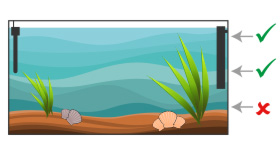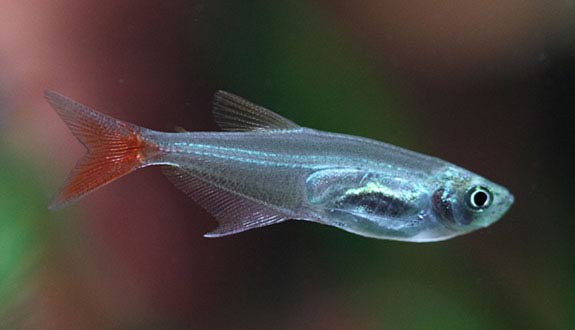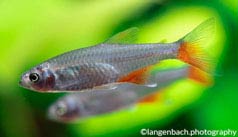

Alternative species (click on the thumbnail to see the card)
Names
Scientific name
Prionobrama filigera
Aphyocharax filigerus
Aphyocharax analis
Aphyocharax analialbis
Bleptonema amazoni
Paragoniates muelleri
Prionobrama madeira
Common name
Glass bloodfin tetra
Origin

Origin: Bolivia, Brazil, Colombia, Ecuador and Peru
Biotope: Amazonian
Dimorphism

The male is smaller and slenderer than the female. The ovarian task of the female is visible by transparency
Group

Characidae
Volume

200 L / 44 imp gal / 53 US gal
Parameters

T°: 22 to 28°C or 72 to 82°F
pH: 6 to 6.5
Hardness: 5 to 25°dGH
Difficulty

Easy
Size

6 cm (2.4")
Longevity

3 to 5 years
Living zone

Middle and top
Individuals

9
Food
How to feed the Glass bloodfin tetra?
Food
How to feed the Glass bloodfin tetra?
Omnivorous: all forms of food are accepted with a clear preference for live prey: daphnids, bloodworms, cyclops... A varied diet will improve its color.
Behavior
What kind of behavior does the Glass bloodfin tetra have?
Behavior
What kind of behavior does the Glass bloodfin tetra have?
It is a lively species, which can swim very fast. Nevertheless, one can qualify the Glass Bloodfish as a peaceful fish. It is a gregarious species that must absolutely be kept in shoals of at least 9 individuals (an odd number seems to work better). Rival males can sometimes squabble with each other. This is why the bigger the group, the more the tensions will be diluted.
Cohabitation
Who can live with the Glass bloodfin tetra?
Cohabitation
Who can live with the Glass bloodfin tetra?
Pacific with all, it can live in a community aquarium because it does not pay much attention to the other inhabitants of the aquarium.
When adult, it can for example be associated with Scalar, Discus, Corydoras, Apistogramma or Mikrogeophagus.
On the other hand, avoid large fast-growing species with high living areas (food competition could be fierce).
Breeding
How to breed the Glass bloodfin tetra?
Breeding
How to breed the Glass bloodfin tetra?
The breeding of the Glass Bloodfish is possible.
Place in a spawning tank (20 L or 4.4 Imp Gal or 5.3 Us Gal) equipped with a protective grid, a male and a female. Beforehand, you will have separated the males from the females. Prepare the individuals by feeding them abundantly with live prey. Lightly light the tank and plant some clumps of fine-leaved plants like Java moss. The temperature will be 24 to 27°C 75 to 81°F and KH at 2° (beyond 4°, the fry will die).
Spawning usually takes place in the evening. As soon as you see the eggs, remove the parents. A spawn has about 300 translucent eggs and the incubation lasts between 14 and 15h.
Fry food: infusoria, nauplies of artemia and cyclops.
Its aquarium
Which aquarium for the Glass bloodfin tetra?
Its aquarium
Which aquarium for the Glass bloodfin tetra?
It likes well-planted aquariums and floating plants will reassure it. However, allow enough space for swimming. You can therefore focus on the sides of the aquarium for example.
Add to your decoration some roots and twigs of driftwood, or even a carpet of dried leaves that will recall its natural environment.
It is important to cover your aquarium because at the slightest fright, these fish are likely to jump outside the tank.
Good To know
Find all additional information!
Good To know
Find all additional information!
Too acidic water can mold the edge of the fins. Otherwise, the Glass Bloodfish is quite robust and quickly gets used to its new environment. Because of this, it can be recommended to beginners.
It differs from Aphyocharax Anisitsi in the absence of red on its anal and ventral nerves.
Yours photos!
Comments
Sort by:
Please login to post comments


